Introduction
In 2020, Nikon announced the Z 20mm f/1.8 S lens, calling it a fast, ultra-wide prime for landscapes, environmental portraits and interior shooting. The S-line lens is produced for Nikon's mirrorless cameras (Nikon Z6 II, Nikon Z7 II) with their short flange focal distance (distance between the mount and the sensor) of 16 mm. For comparison: Nikon's older F-mount flange focal distance for DSLR cameras (Nikon D850, Nikon D6) is 46.50 mm. The shorter flange focal distance and the larger inner mount diameter of Nikon's mirrorless cameras allows for the construction of lenses with less light fall off at the edges of the sensor and better resolution.
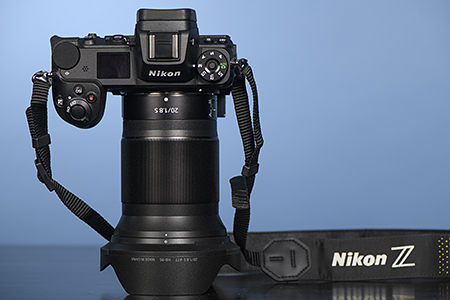
The Nikon Z 20mm f/1.8 S is the sibling of the often praised Nikon AF-S 20mm f/1.8G ED so let's see how they compare in specifications.
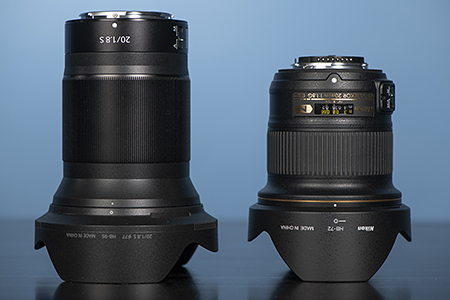
| Specifications: | Nikon Z 20mm f/1.8 S: | Nikon AF-S 20mm f/1.8G ED: |
|---|---|---|
| Lens construction: | 14 elements in 11 groups | 13 elements in 11 groups |
| ED glass elements: | 3 | 2 |
| Aspherical elements: | 3 | 2 |
| Diaphragm blades: | 9 | 7 |
| Nano crystal coat: | Yes | Yes |
| Closest focusing: | 0.2 m / 0.66 ft | 0.2 m / 0.66 ft |
| Maximum Reproduction Ratio: | 0.19x | 0.23x |
| Angle of View (FX): | 94° | 94° |
| Filter: | 77 mm | 77 mm |
| Hood: | HB-95 | HB-72 |
| Dimensions: | 3.4 x 4.3 in (84.5 mm x 108.5 mm) | 3.2 x 3.1 in (82.5 mm x 80.5 mm) |
| Weight: | 17.9 oz. (505 g) | 12.6 oz. (355 g) |
| Appearance: | 2020 | 2014 |
The new Nikon Z 20mm f/1.8 S is about one inch longer than the Nikon AF-S 20mm f/1.8G. The Z lens might not be stowed away in that side pocket in which the G lens just fits nicely. With the sun hood mounted, the Z lens puts 533 g on the scale, while the older G lens weighs 378 g - a difference which can be felt. However, if one wishes to mount the older G lens on a mirrorless camera, an FTZ adapter is needed and with the FTZ mounted, the G lens is actually taller than the Z lens and about the same weight (the combination weighs 536 g with the sun hood attached).
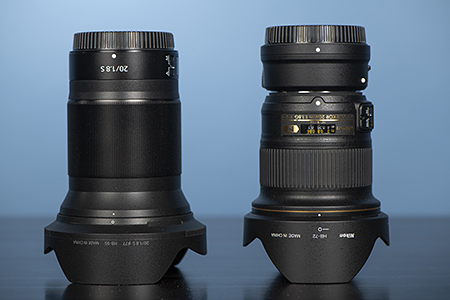
The Nikon Z 20mm f/1.8 S balances well with the Nikon Z6 and the combination is still light enough to be carried around all day (comparable to the Z6 / Nikon Z 24-70mm f/4 S combination). On a side note, the portable iOptron Skyguider Pro star tracker mount still easily handles the combination, tracking the stars accurately for several minutes.
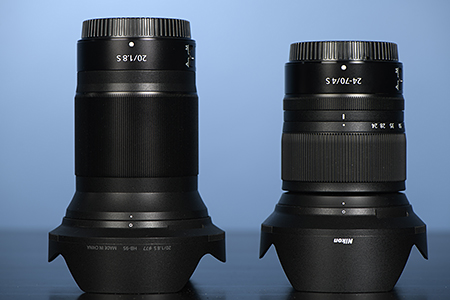
The computed Modulation Transfer Functions (MTF) can be seen below. The horizontal axis of the MTF diagrams shows the distance from image center to the image corner measured in millimeters while the vertical axis displays contrast values for the lens when the aperture is wide open (f/1.8). The red 10 lines/mm curves S10 and M10 are a measure for contrast reproduction, while the blue 30 lines/mm curves S30 and M30 are a measure for the resolution of the lens. The higher and straighter the lines, the better the lens. There are two red curves for the 10 lines/mm measurement (S10, M10) and two blue curves for the 30 lines/mm measurement (S30, M30). They are called sagittal and meridonial curves. Sagittal curves are obtained by using a test chart with line pairs which are parallel to the sensor diagonal. Meridonial curves are obtained by using a test chart with line pairs which are perpendicular to the sensor diagonal.
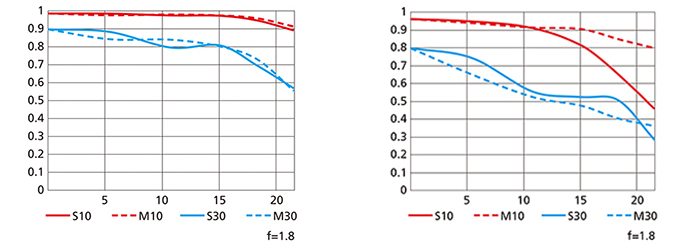
Both lenses display excellent contrast reproduction in image center (see red lines; values above 0.9 or 90 percent are considered to be very good). While the Z lens contrast reproduction stays excellent across the whole image field, the contrast reproduction of the G lens shows some weaknesses in the image corners.
Sharpness values for the Z lens are considerably better than for the G lens (see blue lines; in image center but especially in the corners), indicating less field curvature. In addition, the meridonial and sagittal curves are impressively close together for the Z lens, indicating very little astigmatism (especially important in astrophotography). However, MTF diagrams only tell us part of the story since all kinds of aberrations are at play and Nikon's graphs are only obtained at the widest aperture of the lens (just to be clear: they are calculated, not measured).
The optical construction details for both lenses can be seen below.
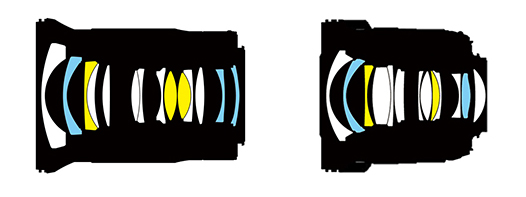
Continue reading: Part II: Optical performance (astrophotography)